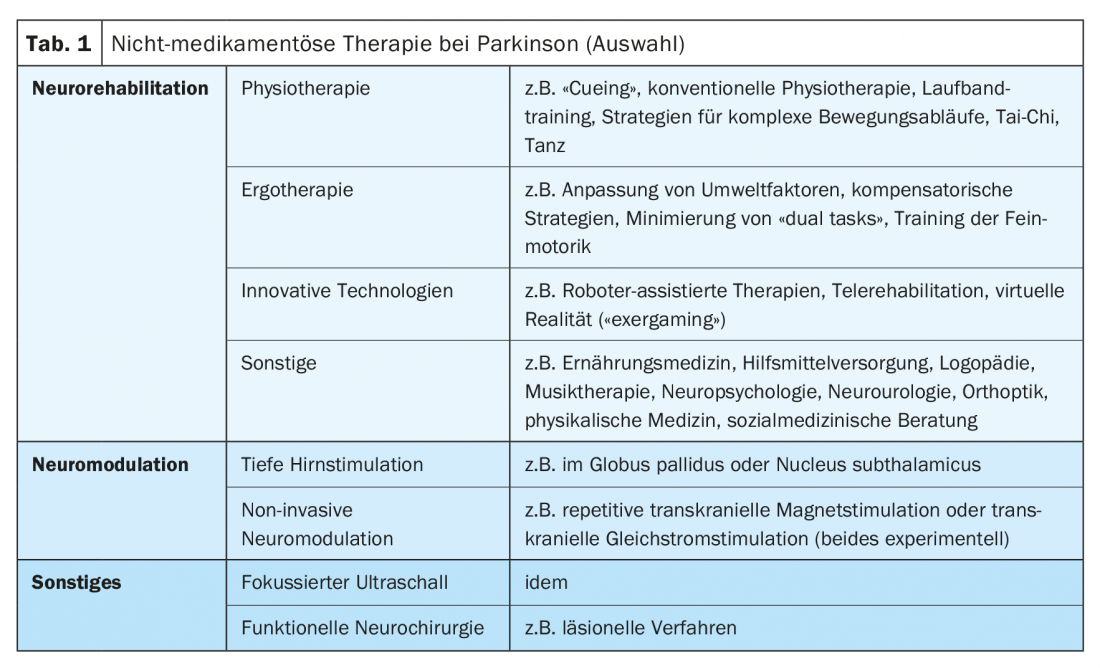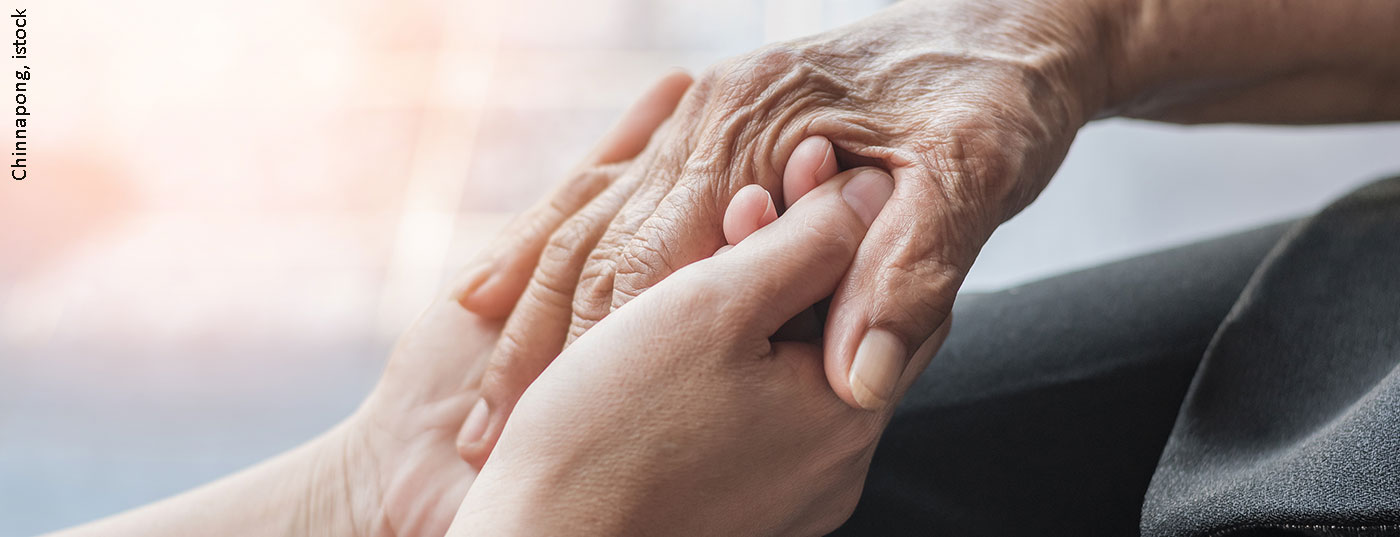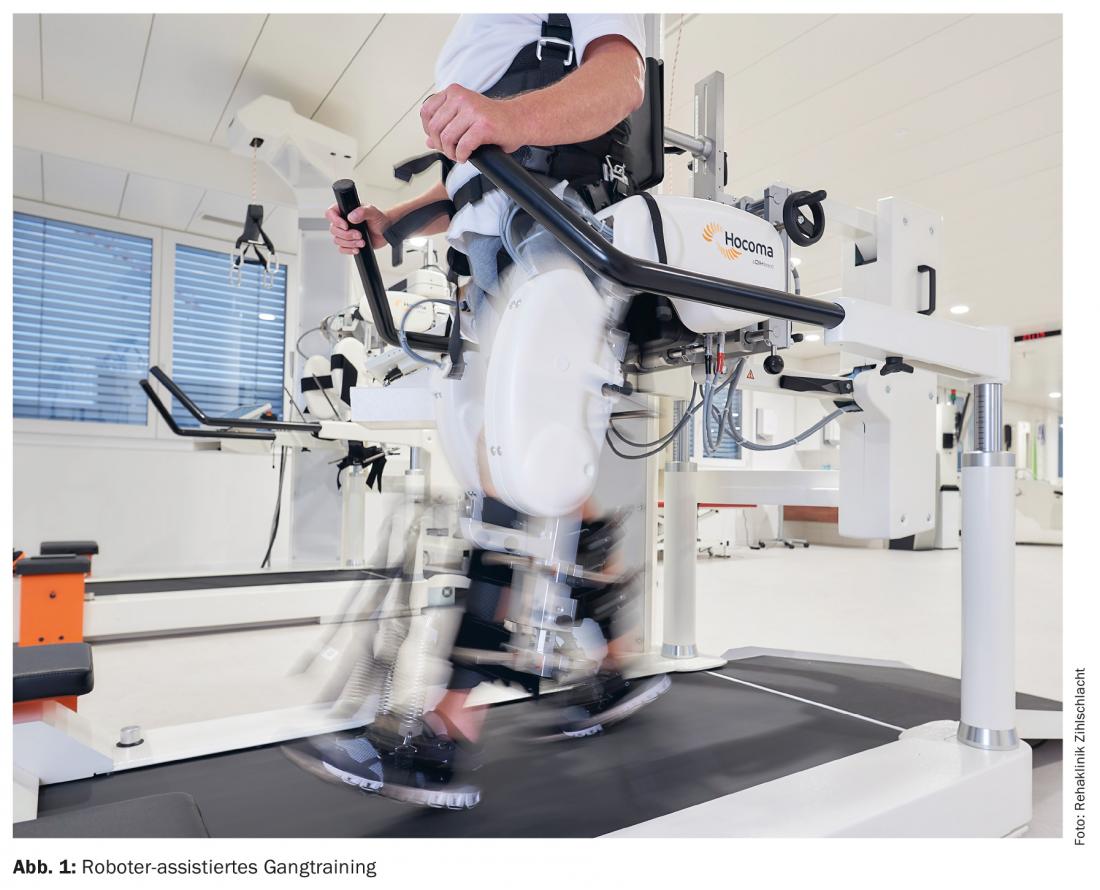Physical activity likely reduces the risk of developing Parkinson’s disease later in life. Accordingly, non-drug therapy for Parkinson’s is becoming increasingly important. Essentially, it involves neuromodulation and neurorehabilitation in advanced patients.
Nonpharmacologic therapy for PD essentially involves neuromodulation and neurorehabilitation in advanced patients. The article focuses on the rehabilitative treatment of patients with Parkinson’s disease with particular attention to special treatment problems and innovative therapeutic approaches. Procedures such as deep brain stimulation or non-invasive neuromodulation are not discussed in detail, nor is focused ultrasound as an experimental therapeutic alternative to deep brain stimulation. Certain areas of neurorehabilitation such as speech therapy, neuropsychology, and visual rehabilitation are also not discussed (Table 1).

Somatic rehabilitation for Parkinson’s disease
Physical activity likely reduces the risk of developing Parkinson’s disease later in life. According to a Swedish meta-analysis of the six studies available at the time, physically active individuals have a lower risk (“hazard ratio”: 0.66) of developing Parkinson’s disease later in life compared with physically inactive individuals [1].
In physiotherapy or occupational therapy, exercise describes a physical activity that is planned, structured and repeated in order to (re)learn or maintain a movement function. Feedback can help patients to go beyond their perceived abilities or to become more aware of movements that were previously automatic or unconscious. Numerous studies are available on the effectiveness of physiotherapy in all its variants for Parkinson’s disease, some of which are briefly presented below. In the 1990s, one of the first controlled studies was published in which the mobility of patients with Parkinson’s disease improved with participation in a 4-week rehabilitation program [2]. However, this improvement did not persist when returning to usual physical activity. LSVT®BIGis probably one of the most widely used procedures in the therapeutic treatment of PD patients and was introduced by Farley and Koshland [3]. In this intensive treatment, patients exercise large amplitude movements 4 times a week for 1 hour a day for 4 weeks. LSVT®BIGwas more effective than “Nordic walking” or self-therapy in the home setting in a controlled study [4]. The PRET-PD study found that 2×-weekly progressive strength training for 24 months resulted in a reduction in motor symptoms as measured by the UPDRS-III. 3×-weekly treadmill training at high intensity (80% of heart rate reserve) or low intensity (40% of heart rate reserve) was compared with non-aerobic strength training [5]. All three groups showed improvement in walking speed, while the strength training also improved muscle strength. Therefore, a combination of aerobic and non-aerobic training elements was proposed. Training of compensatory steps can be used to treat postural instability in Parkinson’s disease. Tai-chi probably leads to an improvement of balance disorders and reduction of the frequency of falls in Parkinson’s disease [6]. In addition, the HiBalance program was developed as a method for treating balance disorders in Parkinson’s disease. Regarding occupational therapy, individual domiciliary treatment resulted in subjective improvement in activities of daily living [7]. In addition, a targeted occupational therapy domiciliary program (HOMEDEXT) likely improves fine motor skills in Parkinson’s disease patients.
Although many studies have relatively small case numbers, it is highly likely that neurorehabilitation is effective in treating patients with Parkinson’s disease. However, it is unclear on which mechanisms the symptomatic effect is based and whether physical activity positively influences the course of the disease. The SPARX study in de novo PD patients concluded that high intensity treadmill exercise should be further investigated for a disease-modifying effect [8]. Further evidence of a possible disease-modifying effect of aerobic exercise came from the Park-in-Shape study [9].
Postural disorders: Camptocormia
A stooped posture is one of the typical characteristics of Parkinson’s disease. Pronounced forms are called camptocorms. Other postural disorders in Parkinson’s include antecollis and Pisa syndrome. The prevalence of these postural disorders is 11.2% for camptocormia, 8.5% for Pisa syndrome, and 6.5% for antecollis, with mixed forms occurring [10].
Camptocoria in Parkinson’s disease was first described in 1999 in eight patients in whom L-dopa resulted in no change or worsening of malposition. The more common upper camptocormia (≥45°) has the flexion point between the lower thoracic and upper lumbar spine, whereas in the less common lower camptocormia (≥30°) it is at the level of the hip joint. The main criterion for distinguishing between camptocormia and kyphoscoliosis is the ability to correct the malposition through various maneuvers, such as lying down or leaning against a wall. The angle of the lines between the lateral malleolus and the spinous process L5 and between the spinous processes L5 and C7 is used to determine the total camptocoria [11]. The superior camptocoria is measured by the lines connecting the vertebral fulcrum to the spinous processes L5 and C7. These measurements can be performed with the help of the NeuroPostureApp©. Possible etiologic factors include muscular rigor, axial dystonia, weakness due to myopathy, body schema disturbances in impaired self-awareness, and structural changes in the spine, although the pathophysiology of camptocoria in PD remains elusive.
Response to dopaminergic medication or deep brain stimulation depends on various factors, such as the duration of camptocormia, but is often unsatisfactory. Intramuscular injections with botulinum toxin or lidocaine may help, but data are insufficient and often inconsistent. Therefore, postural rehabilitation plays an important role in the treatment of camptocormia. This involves passive and active postural training, visual and proprioceptive postural control, and functional exercises, among others [11]. Camptocormia completely disappeared in one case when using a 6-kg, low-hanging backpack and reappeared after the backpack was discarded. The use of a high rollator can also be useful. Furthermore, the fitting of an orthosis can be considered. In individual cases, the malposition can be corrected surgically, but complications and surgical revisions are common.
“Freezing of Gait (FOG)”
FOG has been defined as an episodic inability to generate effective steps lasting for seconds in the absence of any known cause other than a Parkinson’s disease or other complex gait disorder. Alternatively, FOG has also been defined as a brief episodic absence or marked reduction in forward movement of the feet despite the intention to walk. When a patient advances, the following sequence of events results when FOG occurs: a) a significant and increasing decrease in stride length; b) a significantly reduced range of motion in the hip, knee and ankle joints; (c) impaired coordination of the step cycle, which is difficult to distinguish from festination; and (d) high-frequency alternating tremor-like movements [12].
Clinically, three different forms of FOG can be distinguished: a) very small steps; b) Tremor-like movements on the same spot; c) Akinesia. FOG most often occurs during takeoff, turning, in confined spaces, under stress, or when distracted. Impaired bilateral coordination of walking predisposes to the occurrence of FOG, especially in activities that require a high degree of left-right coordination. Turning 360° in combination with a “dual task” was described as the most important trigger of FOG. During reversal, “non-freezers” and control subjects reduced their cadence, while “freezers” increased their cadence. The etiology of FOG has not yet been conclusively determined. During an episode of FOG, activity of the subthalamic nucleus and mesencephalic locomotor region is reduced. Increased connectivity of subcortical and cortical regions involved in the processing of sensory and spatial-visual signals supports the hypothesis of an overload in the basal ganglia loop that ultimately leads to the occurrence of FOG [13].
In treatment, a distinction must be made between FOG that occurs during the on or off drug state of PD patients. FOG during the off state is usually ameliorated by optimizing drug therapy. Focused attention and external stimuli (“cues”) can help break through FOG. Training using “cueing” at home had positive effects on FOG, gait, and balance [14]. The decrease in efficacy after this intervention ended demonstrates the need for “cueing” devices that can be used in the long term. “Open-loop” devices that offer visual or auditory stimuli with a set rhythm can improve gait, but often work unreliably or may worsen FOG in some patients. A wearable device for real-time detection of FOG that automatically delivers an audible stimulus when FOG is detected, which lasts until the person starts walking again, was developed back in 2010. This device detected FOG online with a sensitivity of 73.1% and a specificity of 81.6%. The efficacy of another wearable “closed-loop” device with visual-acoustic stimuli was studied in thirteen Parkinson’s disease patients with FOG in the off-medication state [15]. After training and removal of the device, walking speed and stride length were improved. The number of devices dealing with prediction or detection of FOG has increased significantly since then. According to a recent review, 68 such devices have been described to date [16]. Until “closed-loop” devices are used in everyday clinical practice, conventional “cueing” techniques will continue to play the most important role in physiotherapeutic treatment and aid provision.
Robot-assisted therapies
Robot-assisted therapies have been particularly studied for gait training in Parkinson’s disease patients. Robot-assisted gait training distinguishes between exoskeleton-based and end-effector-based technology (Fig. 1) . The former uses an exoskeleton that is adapted to the body and moves the extremities directly. In contrast, end effector-based robots move the lower extremities via foot plates. Devices from both groups such as the Lokomat®, the “Gait Trainer” and the G-EO robot have been investigated so far. In most studies, robot-assisted gait training was compared with treadmill training. Although in some studies robot-assisted gait training performed better than treadmill training in some aspects, data remain insufficient and sometimes inconsistent. However, several studies indicate that robotic-assisted gait training is superior to treadmill training in the treatment of FOG [17].
Virtual reality
Virtual reality is increasingly being used in neurorehabilitation, particularly of gait and balance disorders in Parkinson’s patients. Here, WiiTM with “balance board” from Nintendo and the Xbox Kinect™ from Microsoft were frequently examined. Both systems seem to be suitable for neurorehabilitation of Parkinson’s disease patients [18]. Medical technology companies in neurorehabilitation are also increasingly turning to the integration of virtual or augmented reality into their products. Despite evidence that virtual reality leads to more effective and less time-consuming rehabilitation than conventional therapies, little data currently exists to support this claim [19]. Nevertheless, it is likely that “exergaming” will continue to gain acceptance in neurorehabilitation, with the hope that positive effects on cognition can be achieved at the same time.
Take-Home Messages
- Especially in advanced Parkinson’s, non-drug therapies are gaining importance.
- There is hope that physical activity will positively influence the course of the disease in Parkinson’s.
- A particular therapeutic problem in PD is axial symptoms such as camptocoria or FOG.
- Innovative technologies and the use of virtual reality are expected to increase in the neurorehabilitation of Parkinson’s disease.
Literature:
- Yang F, et al: Physical activity and risk of Parkinson’s disease in the Swedish National March Cohort. Brain 2015; 138(2): 269-275.
- Comella CL, et al: Physical therapy and Parkinson’s disease: a controlled clinical trial. Neurology 1994; 44 (3): 376-378.
- Farley BG, Koshland GF: Training BIG to move faster: the application of the speed-amplitude relation as a rehabilitation strategy for people with Parkinson’s disease. Exp Brain Res 2005; 167(3): 462-467.
- Li F, et al. Tai chi and postural stability in patients with Parkinson’s disease. N Engl J Med 2012; 366(6): 511-519.
- Ebersbach G, et al: Comparing exercise in Parkinson’s disease – the Berlin LSVT®BIG study. Mov Disord 2010; 25(12): 1902-1908.
- Shulman LM, et al: Randomized clinical trial of 3 types of physical exercise for patients with Parkinson disease. JAMA Neurol 2013; 70(2): 183-190.
- Sturkenboom IH, et al: Efficacy for occupational therapy for patients with Parkinson’s disease: a randomized controlled trial. Lancet Neurol 2014; 13: 557-566.
- Schenkman M, et al: Effect of high-intensity treadmill exercise on motor symptoms in patients with de novo Parkinson disease: a phase randomized clinical tria. JAMA Neurol 2018; 75(2): 219-226.
- van der Kolk NM, et al: Effectiveness of home-based and remotely supervised aerobic exercise in Parkinson’s disease: a double-blind, randomized aerobic exercise in Parkinson’s disease. Lancet Neurol 2019; 18(11): 998-1008.
- Tinazzi M, et al: Postural Abnormalities in Parkinson’s Disease: An Epidemiological and Clinical Multicenter Study. Mov Disord Clin Pract 2019; 6(7): 576-585.
- Margraf NG, et al: Consensus for the measurement of the camptocormia angle in the standing patient. Parkinsonism Relat Disord 2018; 52: 1-5.
- Gandolfi M, et al: Four-week trunk-specific exercise program decreases forward trunk flexion in Parkinson’s disease: a single-blinded, randomized controlled trial. Parkinsonism Relat Disord 2019; 64:268-274.
- Nutt JG, et al: Freezing of gait: moving forward on a mysterious clinical phenomenon. Lancet Neurol 2011; 10(8):734-744.
- Potvin-Desrochers A, et al: Changes in the resting-state functional connectivity related to Freezing of Gait in Parkinson’s disease. Neuroscience 2019; 418: 311-317.
- Nieuwboer A, et al: Cueing training in the home improves gait-related mobility in Parkinson’s disease: the RESCUE trial. J Neurol Neurosurg Psychiatry 2007; 78(2): 134-140.
- Espay AJ, et al. At-home training with closed-loop augmented-reality cueing device for improving gait in patients with Parkinson disease. J Rehabil Res Dev 2010; 47: 573-581.
- Pardoel S, et al: Wearable sensor-based detection and prediction of freezing of gait in Parkinson’s disease: a review. Sensors 2019; 19(23): 5141.
- Cappeci M, et al.: Clinical effects of robot-assisted gait training and treadmill training for Parkinson’s disease. A randomized controlled trial. Ann Phys Rehabil Med 2019; 62(5): 303-312.
- Marotta N, et al: Nintendo WiiTM versus Xbox KinectTM for functional locomotion in people with Parkinson’s disease: a systematic review and network meta-analysis. Disabil Rehabil 2020; doi:10.1080/09638288.1768301.
- Canning CG, et al: Virtual reality in research and rehabilitation of gait and balance in Parkinson disease. Nat Rev Neurol 2020; 16(8): 409-425.
InFo NEUROLOGY & PSYCHIATRY 2020; 18(5): 6-9.













